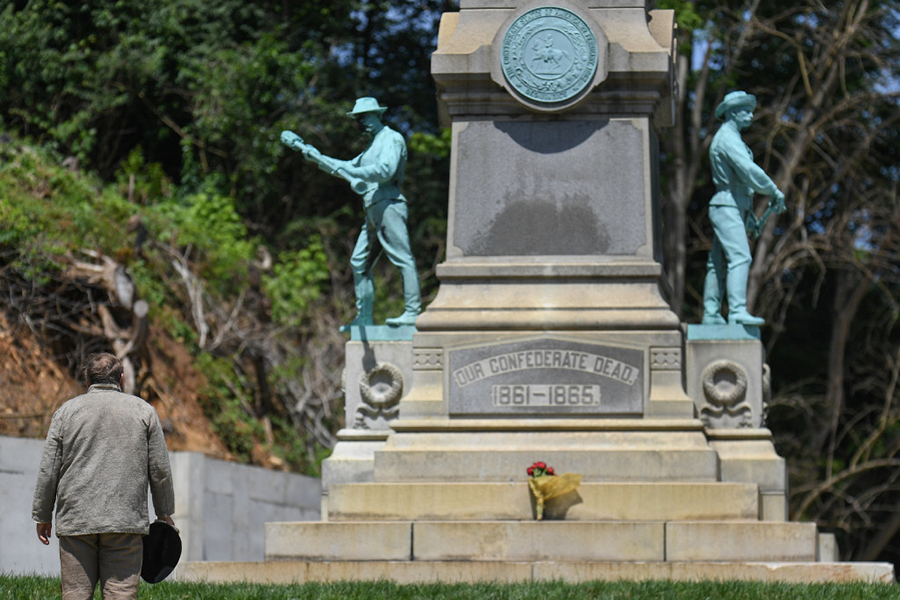Inside the hidden history of confederate memorials
Loading...
The city of New Orleans has been busy evicting its Confederate monuments, sparking a national debate over how Americans should remember the Civil War. One thing has been nearly forgotten: the surprising hidden history of the monuments themselves.
Their past is marked by female empowerment, massive denial, and a surprising twist linked to – of all things – the efficiency of American statue manufacturers. And oh yes, it's a myth that the soldier statues all face north toward the enemy.
Texas historian Kelly McMichael, a professor at American Public University, digs deep into world of Confederate monuments in her 2013 book Sacred Memories: The Civil War Monument Movement in Texas.
In an interview with the Monitor, McMichael explains how Confederate monuments came into being – they didn't pop up immediately after the war – and explores their meaning.
"Each community chooses the story it wants to tell about itself and how it defines its past," she says. "You can see that in what they choose as public art – how the decisions were made, who pushed for it. It shows how people represent themselves."
Q: It seems like the South has more Civil War monuments than the North. Is that true?
They may be more equal than you realize. You may not see them as much in New York City, but if you go into more rural areas in the North, you're going to see monuments in the county seats, often the exact same sculpture that you'd see in the South. It was common for a group in Vermont, say, to order the same statue as a group in Mississippi. They were mass produced, ordered from a catalog.
Q: Wait, so you'd see identical statues of Civil War soldiers on both sides of the Mason-Dixon line?
The inscriptions and the pedestals could be different since they might be made locally by a local stone cutter. But they'd order the statue parts from a catalog. It became a big business, and there were specific places that would sell these monuments of various styles.
Q: In your book, you track down dozens of large-scale Civil War monuments in Texas, including three that honor the Union. But they weren't generally built right after the war. Why not?
The bulk of Civil War monuments in Texas and the US, at least in the South, were erected between 1885 and 1915. The reason is economics. By that point, the South had recovered enough from the war that they could raise the funds required. The monuments in the North popped up earlier.
Q: Who pushed for the Confederate monuments?
Women generated the idea behind them.
These were women who would have been career people if that had been an opportunity. This was a way for them to be out in public and doing what they considered to be meaningful work. They'd host huge celebrations in honor of the monuments, and most of these would include female speakers, which was unusual at the time. Women had generated the idea and raised the money for it, so you could have women speaking in mixed audiences in the public.
Q: What message did they want to send about the war?
Over time, the message became associated with the Lost Cause, when Southerners tried to rewrite the reality of the war and say it was not about slavery but about states rights, that Southerners were upholding the Constitution.
It really was a rewriting of reality, one that was taught in the schools system in the South through the 1960s.
You see this in the aftermath of civil wars. The losers have to write a new story.
Q: How did this play out in the monuments themselves?
Initially the monuments were erected in cemeteries, and then people realized they could be a way to convey a message in public places like public parks. Many of the statues have specific statements on their pedestals or shafts that talk about states rights or upholding the Constitution, that these are true patriots.
Q: Do they all face north?
No. They're placed according to what's best for the locale. If they're on a courthouse square, they'll have chosen a corner for whatever reason, and they'll face out.
These are political and historical messaging machines, but they're also works of public art. They were meant to beautify the cities as part of the City Beautiful movement.
Q: What do you think should happen to Confederate monuments now?
In larger cities with large monuments, they have a responsibility to do one of two things: They have to erect more information that explains them, or they need to do what New Orleans did and move them into a place like a museum where a larger story can be told.
It's not acceptable to leave them and not have a counter story that explains what was going on at the time.







